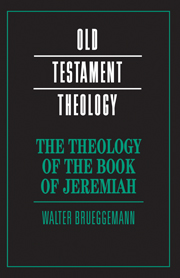Book contents
- Frontmatter
- Contents
- General Editors' Preface
- Preface
- List of Abbreviations
- 1 CRITICAL ACCESS TO THE BOOK OF JEREMIAH
- 2 THE THEOLOGY OF THE BOOK OF JEREMIAH
- 3 THE PLACE AND FUNCTION OF THE BOOK OF JEREMIAH WITHIN THE OLD TESTAMENT
- 4 THE CONTINUING INFLUENCE OF THE BOOK OF JEREMIAH
- Further Reading
- Author Index
- Scriptural Index
3 - THE PLACE AND FUNCTION OF THE BOOK OF JEREMIAH WITHIN THE OLD TESTAMENT
Published online by Cambridge University Press: 05 June 2012
- Frontmatter
- Contents
- General Editors' Preface
- Preface
- List of Abbreviations
- 1 CRITICAL ACCESS TO THE BOOK OF JEREMIAH
- 2 THE THEOLOGY OF THE BOOK OF JEREMIAH
- 3 THE PLACE AND FUNCTION OF THE BOOK OF JEREMIAH WITHIN THE OLD TESTAMENT
- 4 THE CONTINUING INFLUENCE OF THE BOOK OF JEREMIAH
- Further Reading
- Author Index
- Scriptural Index
Summary
It is usual to study books of the Bible (and more specifically the Old Testament) one at a time, each as a discrete literary corpus. Thus, commentaries focus on one book at a time. That practice is further reinforced by the series in which the present volume stands, for that series – including this study of Jeremiah – proceeds “book by book.” But by virtue of the canon, the books of the Bible never stand completely discrete and apart from each other. It is clear that the traditioning process that led to canon was a highly contested one in which competing voices advocated different pieces of literature. Consequently, the outcome of canon is evidently a compromise in which the various interpretive interests are juxtaposed with each other and “books” (scrolls) stand in a variety of relationships to each other. It is equally clear that such interpretive contestation is evident within many of the biblical books themselves.
Our focus in this chapter is on the Book of Jeremiah as it is situated amid the other books of the canon of the Old Testament. It will be clear in this exposition that the Book of Jeremiah – rooted in an imaginative prophet and developed in elongated fashion by a passionate, ongoing community of interpreters – plays a vigorous role in the interpretive contest for the future of Judaism.
- Type
- Chapter
- Information
- The Theology of the Book of Jeremiah , pp. 134 - 186Publisher: Cambridge University PressPrint publication year: 2006



